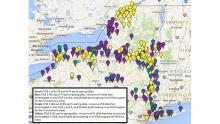STLE Grant
About the Strengthening Teacher and Leader Effectiveness (STLE) Grant Program

Background and Purpose:
Beginning in 2012 as part of the Race to the Top (RTTT) proposal, the Department awarded $83 million in funds under the Strengthening Teacher and Leader Effectiveness (STLE) competitive grant program. These funds helped Local Educational Agencies (LEAs) take a comprehensive systems approach to prepare, recruit, develop, retain and provide equitable access to the most effective teachers and principals as part of their implementation of the Annual Professional Performance Review (APPR) system.
Across four grant cohorts, school districts and local unions collaborated to develop programs that focused on various elements of a strategically planned Teacher and Leader Effectiveness (TLE) Continuum, including preparation, recruitment and placement, induction and mentoring, evaluation, ongoing professional development/professional growth, performance management and career ladder pathways.
Reach of the Program:
STLE grants impacted a total of 221 LEAs, representing approximately one-third of all districts and Boards of Cooperative Educational Services (BOCES) in the State. Programs reached more than half a million students, 42,000 teachers, 1,000 principals, and 650 assistant principals across the State. The STLE grant program closed on June 30, 2015. Initial reporting indicates that:
- 97% of STLE grantees intend to sustain the work they began under RTTT following the conclusion of the grant.
- 87% of STLE grantees intend to sustain their career ladder pathways developed or enhanced through the grant.
Impact and Promising Practice:
Participants were able to better address student achievement outcomes and increase the quality, quantity, and diversity of their educator workforce through the use of evaluation results in the design and implementation of comprehensive talent management strategies that address multiple components of the TLE Continuum.
STLE LEAs were able to address five common talent management challenges through the strategic use of the TLE Continuum, including:
- Preparation: Approximately 31% of grantees partnered with institutions of higher education (IHEs) in order to better prepare future educators.
- Recruitment: More than 25% of the LEAs included differentiated incentives for work associated within hard-to-staff subject areas and buildings.
- Development: More than 72% of grantees worked to increase the effectiveness of their staff by developing targeted professional development based on educator evaluation ratings.
- Retention: 100% of grantees were focused on retaining their top talent through implementation of career ladder pathways or recruitment and transfer awards. Many worked on selective retention efforts, ensuring they were basing tenure and other staffing decisions on effectiveness ratings.
- Ensuring Equitable Access: Nearly 65% of STLE grantees used financial stipends and redefined roles and responsibilities to extend the reach of highly effective educators.
Through the STLE grant program, the Department was able to see how educator leadership in career ladder pathways, connected with the evaluation system and analysis of student learning, is an effective strategy to address educational inequities across the State and to close achievement gaps. Extensive site visits, regular reporting, and status update calls allowed the Department to better understand the ways in which STLE grantees have designed career ladder pathways that provide career advancement opportunities and support efforts across multiple components of the TLE Continuum while recognizing and rewarding excellence.
Related Resources:
To learn more about STLE and access specific examples of returns on investment, increased student achievement, and improved talent management please see the New York State Career Ladder Pathway Local Education Agency Profiles and the STLE Interactive Map. In addition, please see the New York State Framework for Career Ladder Pathways to learn about how lessons learned through STLE has shaped the Department’s plan for the expansion of career ladder pathways as part of the State’s equity strategy.
STLE Request for Proposal(s):
Follow these links to read the STLE Request for Proposal(s):
- STLE 1 (October 31, 2012 – June 30, 2014)
- STLE 2 (October 1, 2013 – June 30, 2015)
- STLE 3 (March 3, 2014 – June 30, 2015)
- STLE D (November 1, 2014 – June 30, 2015)
STLE Grantee Program Abstracts and Summary Reports:
Each lead recipient of the STLE grant submitted a program abstract, summarizing the initiatives that grant funds would support. Details include what student and talent management needs were to be addressed through grant funded activities, specifically describing how high needs students and shortage areas would be affected. Grantees describe the goals and measurable objectives of their unique program, as well as describe how the initiatives fit into a cohesive and comprehensive Teacher and Leader Effectiveness (TLE) system.
Summary reports for each STLE grantee were developed at the close out of the grant period by the Office of Educator Quality and Professional Development, summarizing the activities of each grantee and the impact the grant monies had within the LEAs.





